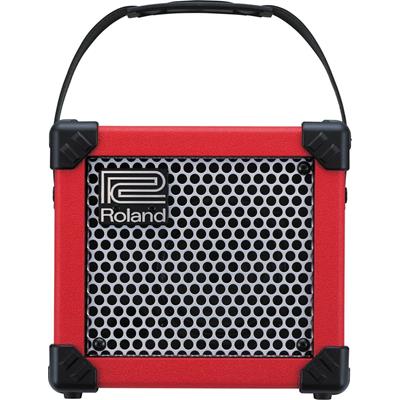| Build Quality: |  |
| Hardware: |  |
| Electronics: |  |
| Sound: |  |
| Value: |  |
| Average: |  |

Pros:
- Extremely portable and lightweight
- Quite loud for its size
- Gives you the option to tune your instrument with three keys
Cons:
- Effects are not as good as on bigger stacks or individual pedals
We should all take a minute and praise the gods for the technological development that we are witnessing. A couple of decades ago, the most basic computer occupied the whole room while today we have extremely portable laptops. This advancement has affected the music industry as well, making it possible to shove powerful tones into the smallest units. The same goes for the amplifiers. You no longer have to carry those heavy amps in order to perform outside your studio. You can simply grab an amp that is the size of the lunchbox and weighs only couple of pounds. Roland Micro Cube is a great representation of that phenomenon. This article will give you a comprehensive insight into the features, controls, and sound of the said amp. The smaller, the better, am I right?
Features
Despite its size, Micro Cube does not joke around. Though it might not seem like it, this little fella packs a bunch of features that are extremely useful for daily utilization. It has a single 5” speaker that emits the sound with 2 watts of power. Micro Cube runs on six AA batteries (which can handle 20 hours of usage) and can also be powered with AC adapter. This amp is equipped with Digital Tuning Fork that allows you to tune your instrument with three key options (normal, half step down, whole step down).
It also comes with Composite Object Sound Modeling (COSM) with six amp styles, including Acoustic, JC Clean, Black Panel, Brit Combo, Classic Stack, and R-Fier Stack. Additionally, Micro Cube has 6 onboard effects, namely, Chorus, Flanger, Phaser, Tremolo, Delay, and Reverb that add up to the diversity of the unit. This amp has a single input that accepts both your instrument and microphone, an ¼” auxiliary input, and a mini input for your MP3, CDs, and other external devices, as well as Rec Out which can be utilized either for recording or headphones (for silent practicing). As you can see, the features of Micro Cube are way more extensive than you would expect from its size.
Controls
The recurrent theme of small guitar amps is that they have just a few controls. Micro Cube is not an exception to that concept. It is extremely easy to tweak because all the knobs dictate their functions and can be understood in no time. After a couple of hours spent on grasping the unit, you will be able to nail any setting even blindfolded. Let’s get straight to the point and find out how each of the controls alters your sound.
The control panel is comprised of two rows of knobs. I will start with the second one because this way it makes more sense in my opinion. Right after the input, you will see a Type Switch knob, which allows you to select one of the amp models or change the type of input by choosing the mic setting. Then we have Gain and Volume knobs. The former strengthens your signal, while the letter adjusts the level of the overall output. The top row starts with the Tuning Fork and Key switches, which allow you to tune your instrument with desirable keys and semitones.
The tone is a sort of EQ, that lets you shape your higher and lower frequencies. Next, we have EFX (a.k.a. effects) knob which enables you to choose between chorus, flanger, tremolo, and phaser and enhance their intensity. Last but not least, we have a separate control for reverb and delay, which operates in the same way. It allows you to choose between these two effects and set their depth. And that’s it. You will have to twist and tweak these couple of knobs and the tone of your dreams will be right at your feet.
Roland Micro Cube Sound
The sound is where the smaller amps have to go through a real test. Incorporating versatile features into a 2-watt unit is way easier than making it sound good. Luckily, Roland nailed that as well. Micro Cube is not loud enough to rock any sort of stage (and it is not supposed to be at this capacity) but for its purpose, it works amazingly. This amplifier makes your instrument sound better and enhances all of its best qualities.
The amp models give you a wide range of sonic options to choose from, allowing you to be clean and subtle and then step into the distorted territory. The onboard effects are a great addition as well since they are thick and saturated, but not overpowering (considering the size of the amp). No matter what your playing style and genre is, Micro Cube will be your little friend that will make everything sound better.
Conclusion
In conclusion, it can easily be said that Roland Micro Cube is what we call a badass amp. It is extremely portable, especially with the stripe included in the package. The fact that it runs on batteries makes it even more convenient since it can be utilized regardless of where you are. Micro Cube offers a usable and extensive set of features. And the best part – it sounds amazing. What else could we ask from an amp that weighs less than our laptops? Nothing much, really. Grab this bad boy, go anywhere you want, and dive into the sweet magic of music. Good luck!






